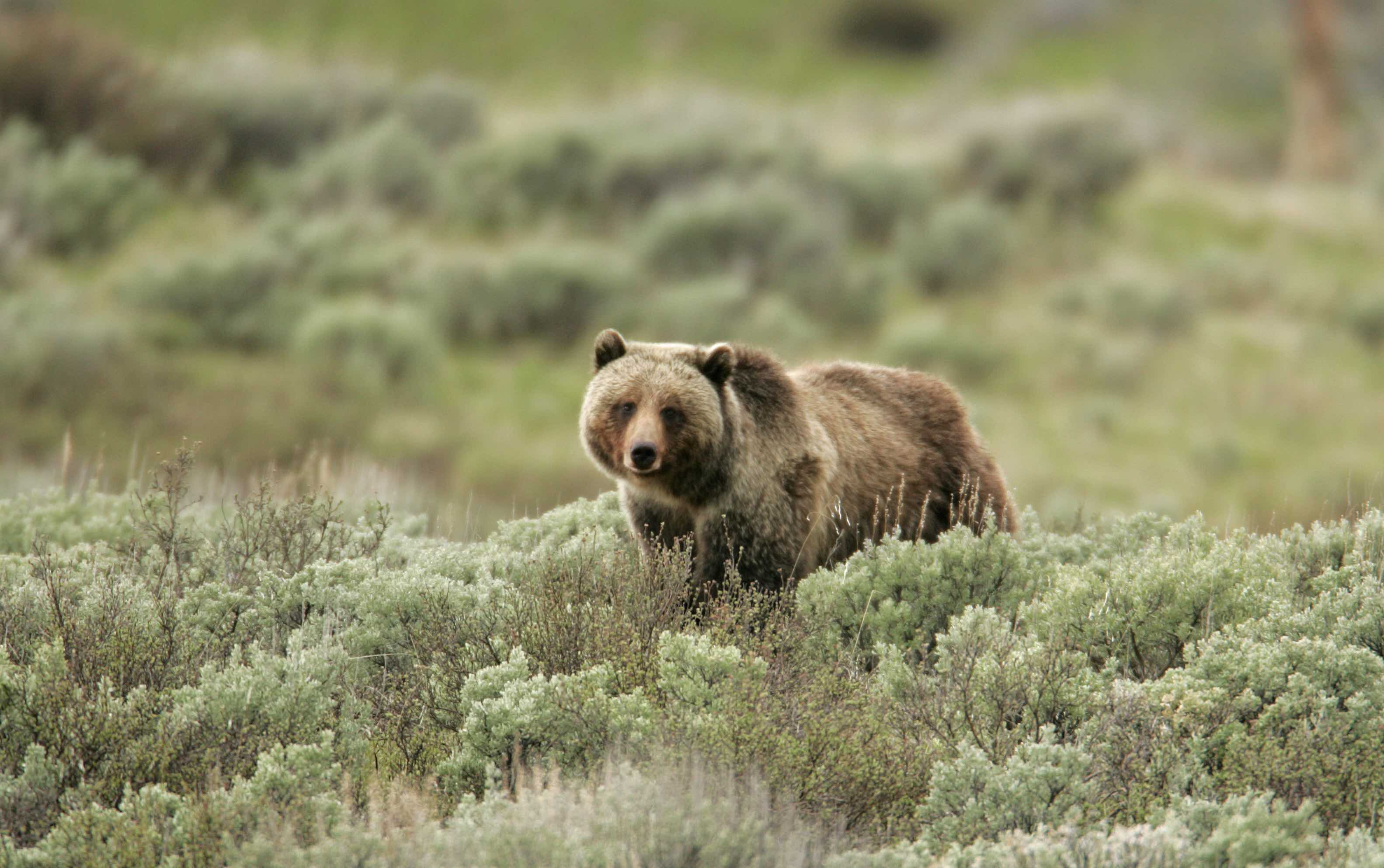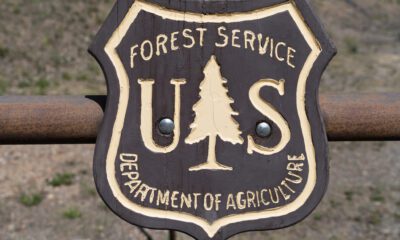Uncategorized
When grizzlies get in trouble
Published
5 years agoon
Posted By
Outlaw Partners

A ‘shared responsibility’
By Jessianne Castle EBS ENVIRONMENTAL & OUTDOORS EDITOR
LIVINGSTON – As June gave way to summer after a prolonged spring in the Rocky Mountains, so too did the month see ranchers turning cattle out to pasture, biologists installing remote cameras to study the comings and goings of wildlife and grizzly bears roving the landscape for food.
Every year, a number of grizzlies come into direct conflict with livestock in Idaho, Wyoming and Montana, often drawn to boneyards, bedding grounds or areas where animals are kept at night. And as the bruins recolonize their historic ranges, communities unused to the idea of living with bears are having to adapt, while those familiar with bears must continue to improve.
When conflict happens
“It’s normal behavior for a bear to be attracted to any resource that might provide nutrition,” said Mike Madel, a biologist for Montana Fish, Wildlife and Parks. Based in Choteau on the Rocky Mountain Front, Madel was hired in 1986 as the state’s first grizzly management biologist in order to lead conflict response and mitigation efforts.
“Bears are an intelligent, large carnivore,” he said over the phone in between setting traps to catch and collar grizzly bears and helping landowners build grizzly-resistant fences. “They have the ability to learn quickly and remember.”
Still listed under the Endangered Species Act, grizzly bears are managed throughout their ranges in the Lower 48 by a team of officials from state and tribal wildlife agencies as well as the U.S. Fish and Wildlife Service—a partnership known as the Interagency Grizzly Bear Committee.
Managers are required to follow distinct guidelines in the event of known conflict situations, such as bears damaging property or exhibiting aggressive behavior. Written in 1986, these guidelines dictate the appropriate response based on the bear’s age, sex, behavior and conflict history.
Hilary Cooley, the FWS grizzly bear recovery coordinator, said agency partners discuss via conference calls safety issues and a bear’s status, as well as whether they have identified the correct bear. If it is a relocation scenario, they negotiate a preapproved site for the bear with land management agencies like the U.S. Forest Service or Bureau of Land Management.
Cooley added that the decision to lethally remove a bear typically comes when it has repeatedly caused problems and is food conditioned or exhibiting dangerous behavior. Oftentimes a bear is relocated first, though Madel says bruins have a knack for returning to their original area.
Speaking about lethal removal following livestock depredation, Madel said, “It’s the worst part of my job, but it’s probably a necessary part of maintaining a positive attitude toward grizzly bears, where landowners are providing some of the best grizzly bear habitat.”
When a producer loses livestock, he or she may seek compensation from the Montana Livestock Loss Board, which was established in 2007 by the state Legislature. After a multiagency investigation confirms the loss was due to predation and identifies the predator—a process that often involves skinning the animal in order to assess bite marks—the rancher or farmer can request the market value of the animal.
Livestock loss claims are paid out from the state general fund through legislative appropriation. So far in 2019, as of June 11, the loss board has paid out $41,150 to 30 landowners, accounting for the deaths of 72 animals caused by grizzly bears, wolves and mountain lions. There have been no claims from Gallatin or Park counties.
An ounce of prevention
Throughout Rocky Mountain states, communities are taking steps to prevent grizzly bear conflict. Within the Big Sky area, landowners are encouraged to be bear-smart and follow the Bear Smart Big Sky campaign, which you can learn more about on page 29.
In newly colonized areas, where bears haven’t appeared on the landscape for decades, such as on the Rocky Mountain Front, the Ruby Valley southwest of Bozeman, the Blackfoot Valley near Missoula or land east of Cody, Wyoming, many livestock producers are voluntarily adopting bear-wise husbandry strategies.
Within Paradise Valley south of Livingston, a group of ranchers has formed the Tom Miner Basin Association, which seeks to promote accountability and responsibility among the area producers in part by using “range riders” who monitor cattle turned out on pasture.
While members of the association declined to comment, and calls requesting interviews were not returned by the Montana Stockgrowers Association or the Centennial Valley Association, Denny Iverson of the Blackfoot Challenge described what ranchers are doing to prevent conflicts near Missoula.
“It’s been interesting to see the progression of the attitude toward grizzly bears,” the rancher said. “[Part of] it’s just getting used to them. As the bears keep getting farther out … there are certain things that are our responsibility, like cleaning up our boneyards or not keeping grain out.”
The Blackfoot Challenge, a coalition of ranchers in the Blackfoot Valley, offers several conflict mitigation approaches. One is an anonymous carcass-removal pickup program.
Historically, Iverson said, many ranchers would put dead cows or calves in a boneyard near their calving grounds—sometimes buried or sometimes heaped—but grizzlies and black bears are drawn to the carcasses. He recalls an instance where he once buried a cow with four feet of dirt. Three days later, he said, a bear had dug it up.
Through a partnership with the Montana Department of Transportation, carcasses are routinely collected during calving season and composted at a facility that also handles roadkill.
“Our [bear] conflicts are way, way down,” he said.
An additional option for livestock producers is to build electric fences around calving or bedding grounds. According to Madel, this is among the most effective options. “[Grizzly bears] will not come across an electric fence that is working properly,” he said.
Wildlife conservation organizations such as Defenders of Wildlife or Greater Yellowstone Coalition provide support for electric fence construction, offering cost-share funds, education and sometimes materials or manpower.
“The reality is it’s a shared responsibility because we all benefit from bears,” said GYC Wildlife Program Associate Brooke Shifrin. “We’re learning there’s a whole lot we don’t understand. Different landscapes require different measures and we have a commitment to listen, learn and find common ground.”
The Outlaw Partners is a creative marketing, media and events company based in Big Sky, Montana.


Upcoming Events
april, 2024
Event Type :
All
All
Arts
Education
Music
Other
Sports
Event Details
Children turning 5 on or before 9/10/2024:
more
Event Details
Children turning 5 on or before
9/10/2024: Kindergarten
enrollment for the 2024-2025 school year can be completed by following the
registration process now.
Children
born on or after September 11, 2019: 4K enrollment is now open for
families that have a 4-year-old they would like to enroll in our program for
the 2023-2024 school year. Please complete the 4K Interest Form to
express your interest. Completing this form does not guarantee enrollment into
the 4K program. Enrollment is capped at twenty 4-year-olds currently
residing within Big Sky School District boundary full time and will be
determined by birth date in calendar order of those born on or after September
11, 2018. Interest form closes on May 30th.
Enrollment now is critical for fall preparations. Thank you!
Time
February 26 (Monday) - April 21 (Sunday)
Event Details
Saturday, March 23rd 6:00-8:00pm We will combine the heart-opening powers of cacao with the transcendental powers of breathwork and sound. Together, these practices will give us the opportunity for a deep
more
Event Details
Saturday, March 23rd 6:00-8:00pm
Time
March 23 (Saturday) 6:00 pm - April 23 (Tuesday) 8:00 pm
Location
Santosha Wellness Center
169 Snowy Mountain Circle
Event Details
We all are familiar with using a limited palette, but do you use one? Do you know how to use a
more
Event Details
We all are familiar with using a limited palette, but do you use one? Do you know how to use a limited palette to create different color combinations? Are you tired of carrying around 15-20 different tubes when you paint plein air? Have you ever wanted to create a certain “mood” in a painting but failed? Do you create a lot of mud? Do you struggle to achieve color harmony? All these problems are addressed in John’s workbook in clear and concise language!
Based on the bestselling “Limited Palatte, Unlimited Color” workbook written by John Pototschnik, the workshop is run by Maggie Shane and Annie McCoy, accomplished landscape (acrylic) and plein air (oil) artists,exhibitors at the Big Sky Artists’ Studio & Gallery and members of the Big Sky Artists Collective.
Each student will receive a copy of “Limited Palette, Unlimited Color” to keep and take home to continue your limited palette journey. We will show you how to use the color wheel and mix your own clean mixtures to successfully create a mood for your paintings.
Each day, we will create a different limited palette color chart and paint a version of a simple landscape using John’s directives. You will then be able to go home and paint more schemes using the book for guidance.
Workshop is open to painters (oil or acrylic) of any level although students must have some basic knowledge of the medium he or she uses. Students will be provided the book ($92 value), color wheel, value scale and canvas papers to complete the daily exercises.
Sundays, April 14, 21 and 28, 2024
Noon until 6PM.
$170.
Time
14 (Sunday) 12:00 pm - 28 (Sunday) 6:00 pm
Event Details
Come join us at Cowboy Coffee as we celebrate a fun night of drinks, games, and meeting others within the community. This event is from 6-8 and all are welcome
Event Details
Come join us at Cowboy Coffee as we celebrate a fun night of drinks, games, and meeting others within the community. This event is from 6-8 and all are welcome to come, if you don’t know who to bring come alone this is a great mixer event! This is an event hosted by Big Sky OUT as we work to provide queer safe spaces throughout the community.
Time
(Sunday) 6:00 pm - 8:00 pm
Location
Cowboy Coffee
25 Town Center Ave. Big Sky, MT 59716










